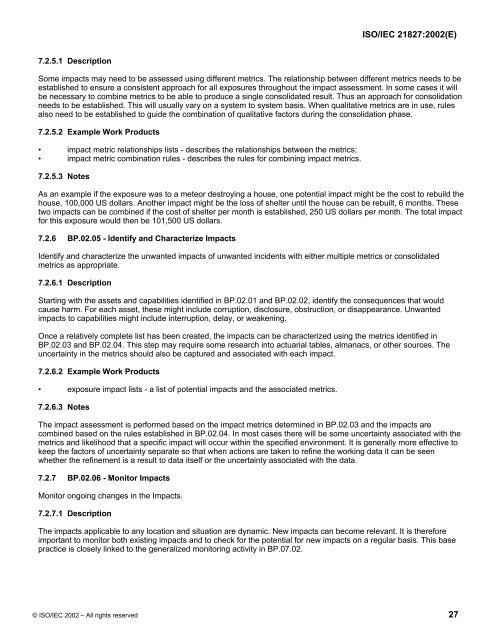ISO/IEC 21827
ISO/IEC 21827
ISO/IEC 21827
You also want an ePaper? Increase the reach of your titles
YUMPU automatically turns print PDFs into web optimized ePapers that Google loves.
<strong>ISO</strong>/<strong>IEC</strong> <strong>21827</strong>:2002(E)<br />
7.2.5.1 Description<br />
Some impacts may need to be assessed using different metrics. The relationship between different metrics needs to be<br />
established to ensure a consistent approach for all exposures throughout the impact assessment. In some cases it will<br />
be necessary to combine metrics to be able to produce a single consolidated result. Thus an approach for consolidation<br />
needs to be established. This will usually vary on a system to system basis. When qualitative metrics are in use, rules<br />
also need to be established to guide the combination of qualitative factors during the consolidation phase.<br />
7.2.5.2 Example Work Products<br />
• impact metric relationships lists - describes the relationships between the metrics;<br />
• impact metric combination rules - describes the rules for combining impact metrics.<br />
7.2.5.3 Notes<br />
As an example if the exposure was to a meteor destroying a house, one potential impact might be the cost to rebuild the<br />
house, 100,000 US dollars. Another impact might be the loss of shelter until the house can be rebuilt, 6 months. These<br />
two impacts can be combined if the cost of shelter per month is established, 250 US dollars per month. The total impact<br />
for this exposure would then be 101,500 US dollars.<br />
7.2.6 BP.02.05 - Identify and Characterize Impacts<br />
Identify and characterize the unwanted impacts of unwanted incidents with either multiple metrics or consolidated<br />
metrics as appropriate.<br />
7.2.6.1 Description<br />
Starting with the assets and capabilities identified in BP.02.01 and BP.02.02, identify the consequences that would<br />
cause harm. For each asset, these might include corruption, disclosure, obstruction, or disappearance. Unwanted<br />
impacts to capabilities might include interruption, delay, or weakening.<br />
Once a relatively complete list has been created, the impacts can be characterized using the metrics identified in<br />
BP.02.03 and BP.02.04. This step may require some research into actuarial tables, almanacs, or other sources. The<br />
uncertainty in the metrics should also be captured and associated with each impact.<br />
7.2.6.2 Example Work Products<br />
• exposure impact lists - a list of potential impacts and the associated metrics.<br />
7.2.6.3 Notes<br />
The impact assessment is performed based on the impact metrics determined in BP.02.03 and the impacts are<br />
combined based on the rules established in BP.02.04. In most cases there will be some uncertainty associated with the<br />
metrics and likelihood that a specific impact will occur within the specified environment. It is generally more effective to<br />
keep the factors of uncertainty separate so that when actions are taken to refine the working data it can be seen<br />
whether the refinement is a result to data itself or the uncertainty associated with the data.<br />
7.2.7 BP.02.06 - Monitor Impacts<br />
Monitor ongoing changes in the Impacts.<br />
7.2.7.1 Description<br />
The impacts applicable to any location and situation are dynamic. New impacts can become relevant. It is therefore<br />
important to monitor both existing impacts and to check for the potential for new impacts on a regular basis. This base<br />
practice is closely linked to the generalized monitoring activity in BP.07.02.<br />
© <strong>ISO</strong>/<strong>IEC</strong> 2002 – All rights reserved 27
















